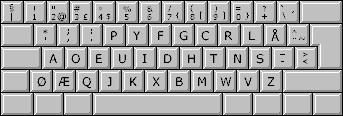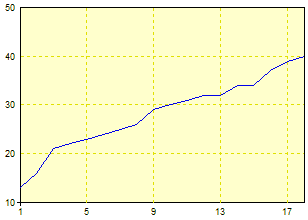Why Dvorak?
The standard Qwerty keyboard layout was designed to minimize jamming in mechanical typewriters. As a result, the most commonly used keys are found along the edges of the keyboard, and many common letter combinations are awkward.
Whatever their faults, computer keyboards are not particularly prone to mechanical jamming. The Dvorak keyboard layout was designed to minimize finger movement, and to use alternating hands for common key combinations (one reason why the vowels are clustered on the left-hand side of the keyboard).
An expert Dvorak typist is 10–15% faster than an expert Qwerty typist. If you’re already an expert Qwerty typist this difference is probably too small to be worth the very real pain of changing (except that Dvorak is ergonomically sounder). But I am not an expert Qwerty typist and never have been. Despite many attempts over the years I’ve never managed to reach true touch-typing Nirvana—too many deeply ingrained bad habits, I suppose. With a frest start, and without relabeling the keys, perhaps I stand a chance. (As long as the keys retain their old, misleading labels, peeking at the keyboard is worse than useless.)
In any case, Dvorak is demonstrably better than Qwerty. A failure to switch would undermine my moral right to make fun of the American failure to switch to metric, and we can’t have that. Really.
This page (from Microsoft) has pictures of Qwerty and Dvorak layouts.
This page (from Stenling) has a picture of a Dvorak layout modified for Norwegian.
Stenling’s placement of the apostrophe is no good for writing English.
My modification has the
 and
and
 keys swapped—an
English-Norwegian hybrid, if you will:
keys swapped—an
English-Norwegian hybrid, if you will:

My layout also fixes a bug in Stenling’s layout: his has a caret rather than an ampersand above the numeral 6. (This is an acknowledged bug that will undoubtedly be fixed in his next release.)
Feel free to download my layout, but don’t come running to me if you get problems. The Stenling site contains installation instructions. (On Windows XP Professional I’ve had success with (1) Adding US English; (2) Setting up US English to use the US Dvorak layout; (3) Installing the new keyboard DLL in Safe Mode. Now I can switch freely back and forth.)
The Dvorak Story
Friday, 1. August 2003
Just after lunch I decide—within minutes of getting the idea—to switch from QWERTY to Dvorak. I swear never to qwerty again until I have fully mastered Dvorak. By practicing diligently over the weekend I hope to be ready for work on Monday morning. Sort of, at least.
I test a touch-typing-tutor-type program called Stamina. It seems to suit my needs; I buy it (shareware, $19).
Monday, 4. August 2003
On my third day I’m up to about 25 wpm, at least in spurts. The most frustrating aspect isn’t the slow speed, but that half my already meagre mental energy goes into the mechanics of keyboard handling. But I am no longer looking at the keyboard!
Thursday, 7. August 2003
I still have a hard time exceeding 30 wpm, except in spurts, but the frustration has tapered off a bit. I no longer use half my brain to figure out which key to press—it's now more like a third.
Monday, 11. August 2003
I didn’t touch the keyboard over the weekend, but I’ve still made some progress—not so much in speed as in accuracy. Training kinetic memory is a very strange thing, whether it be touch-typing or pole-vaulting. You can do only so much in a single session; after that further practice is counter-productive. My brain (or is it my spine) has been doing some kind of reprogramming over the weekend, that’s for sure. I find myself thinking less and less about the keyboard as I write.
Progress Chart

My average rate is quite a bit slower than this graph (from Stamina) suggests.
Extrapolating on day six, it seems inevitable that in a year or so I’ll be zipping along at about a thousand words per minute.
Extrapolating on day ten, the above paragraph is beginning to seem ever so slightly optimistic.
Friday, 5. September 2003
Today marks the end of week five; I’m still going strong. My personal best is now 65 wpm (according to the Stamina five-minute test), and even though that doesn’t really reflect my average speed, I no longer think much about it. I’m confident that real speed will be along eventually.
Friday, 3. October 2003
I’ve broken the 70 wpm barrier.
April 2005
I haven’t so much as thought about Dvorak for the better part of a year. A quick test shows that 100 wpm is no problem, and I am no longer afraid of touching a QWERTY occasionally (for fear that it would ruin my Dvorak).
(Start bottom menu)
Top •
Home
• Articles
• Book
• Resources
Windows Developer Magazine
• R&D Books
• CMP Books
Amazon.com
• Amazon.co.uk
• Contact Petter Hesselberg
(End bottom menu)
